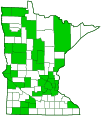leafy spurge hawkmoth
(Hyles euphorbiae)
Conservation • Description • Habitat • Ecology • Distribution • Taxonomy
|
|
||||||||||||||||||
Description |
Leafy spurge hawkmoth is a large exotic moth. It is native to Europe and western Asia. It was introduced into the United States in the 1960s. Since then it has spread widely and its range continues to expand. It now occurs in the northern United States and southern Canada east of the Rocky Mountains. It is found from late May through July in disturbed meadows and other grasslands with large populations of leafy spurge. Larvae feed on the foliage of leafy spurge and other members of the Euphorbiaceae (spurge) family. Adults feed on flower nectar. Adults are large-bodied, 1½″ to 2″ (38 to 50 mm) long, and have a wingspan of 2 9 ⁄16″ to 3 1 ⁄16″ (64 to 77 mm). A narrow white stripe on each side extends from the side of the head, over the eye to the end of the thorax. The antennae are white and have numerous short, comb-like extensions on one side (pectinate). The body is brown. The abdomen has a narrow white stripe on each side between each abdominal segment that does not meet on the upper side. The forewing is long and narrow with a smooth leading edge (costal margin), a convex outer margin, and a slightly concave inner margin. The upperside is light tan with a slight pinkish tinge and is peppered with black specks. There is an olive-brown, almost square patch in the basal area, and another on the costal margin in the median area. An olive-brown postmedial band begins as a broad patch on the inner margin, narrows abruptly, then tapers almost to a point at the apex. The pale area on the outer margin is usually heavily peppered. The hindwing is black with a broad, rose-pink, median band; a narrower, pink, terminal band; and a white patch at the anal angle. The underside of both wings is pink. The larva (caterpillar) is black and brown or entirely black. Each abdominal segment has several rows on tiny yellowish spots and a single large yellowish spot on each side (subdorsally). A black-tipped red horn protrudes from the upper side of the eighth abdominal segment (A8). A narrow, red, upper middle (middorsal) stripe extends from behind the head to the base of the horn. There is a pair of fleshy, leg-like structures on A3 through A6 and on A10. The prolegs on A10 are flattened laterally allowing the caterpillar to tightly grip stems, twigs, and leaves. There is a hardened plate (anal plate) on the upper side of A10. The head, prolegs, and anal plate are colored the same, usually red. Mature caterpillars are up to 2¾″ (7 cm) long and are often found in late summer crossing roads. |
Size |
Total length: 1½″ to 2″ (38 to 50 mm) Wingspan: 2 9 ⁄16″ to 3 1 ⁄16″ (64 to 77 mm) |
Similar Species |
Habitat |
Disturbed meadows and other grasslands with populations of leafy spurge. |
Ecology |
Season |
Probably just a single generation per year in North America: Late May through July. |
Behavior |
Adults are active during the day but mostly late in the day and after dark. They hover like a hummingbird when visiting flowers. They will come to light. |
Life Cycle |
The female lays a single egg or a small cluster of eggs on the underside of a host plant leaf. Pupa overwinter in the ground just below the surface. |
Larva Hosts |
Leafy spurge and other members of the Euphorbiaceae (spurge) family. |
Adult Food |
Flower nectar |
Distribution |
||
|
Sources |
|
| 9/11/2024 | ||
Occurrence |
||
|
||
Taxonomy |
|
Order |
|
Superfamily |
Bombycoidea (Hawk, Sphinx, Silk, Emperor, and Allied Moths) |
Family |
|
Subfamily |
Macroglossinae |
Tribe |
Macroglossini |
Subtribe |
Choerocampina |
Genus |
Hyles |
Subordinate Taxa |
|
Eighty-five subspecies have been described. Only two are currently recognized. Only one occurs in North America. |
|
leafy spurge hawkmoth (Hyles euphorbiae conspicua) leafy spurge hawkmoth (Hyles euphorbiae euphorbiae) |
|
Subordinate Taxa |
|
|
|
Synonyms |
|
Celerio atrolimbata Celerio dolomiticola Celerio euphorbiae Celerio filapjewi Celerio flavidior Celerio grentzenbergi Celerio grentzenbergi-ziczac Celerio lucida Celerio nigrescens Celerio rothschildi Celerio sinensis Celerio strasillai Celerio subiacensis Celerio vandalusica Deilephila esulae Deilephila etrusca Deilephila paralias Sphinx euphorbiae |
|
Common Names |
|
leafy spurge hawkmoth spurge hawkmoth |
|
Glossary
Anal plate
In snakes: the large scale in front of and covering the anus. In turtles: one of the posterior plates of the lower shell (plastron). In Lepidoptera: the often hardened shield on the dorsal surface of the last (10th) segment of the abdomen.
Costal margin
The leading edge of the forewing of insects.
Proleg
A fleshy structure on the abdomen of some insect larvae that functions as a leg, but lacks the five segments of a true insect leg.
Visitor Photos |
||
Share your photo of this insect. |
||
This button not working for you? |
||
Mackenzie Sowers |
 |
Paul Hamilton |
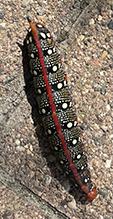 |
Topher |
||
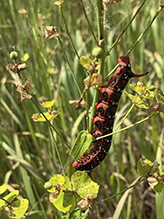 |
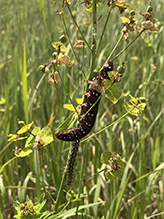 |
|
Several large caterpillars found along trails around Quarry Lake. |
||
Ann Fink |
||
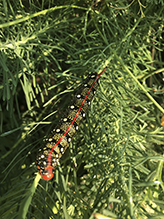 |
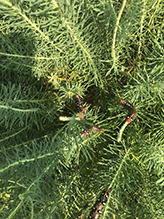 |
|
Leafy spurge hawk moth Your website shows the “Distribution” of the hawk moth but does not show Duluth as part of that area. Yesterday I found 8 large and 2 small caterpillars on my Cushion Spurge. I also took a video clip of a hawk moth on my patch of impatient flowers. You may want to update your Distribution on your website. |
||
Lucy Morrissey |
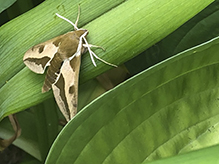 |
MinnesotaSeasons.com Photos |
||
|
||
|
||

Slideshows |
|

Visitor Videos |
||
Share your video of this insect. |
||
This button not working for you? |
||
|
Other Videos |
||
Hyles euphorbiae |
About
Sep 22, 2017 HYLES EUPHORBIAE - Hyles euphorbiae, Celerio euphorbiae, Wolfsmilchschwärmer, Spurge Hawk-moth, Zmrocznik wilczomleczek, Lišaj mliečnikový, Lišaj pryšcový, Бражник молочайный, Esfinge de la Lechetrezna, Tyräkkikiitäjä, Vitsprötad skymningssvärmare. |

Visitor Sightings |
||
Report a sighting of this insect. |
||
This button not working for you? |
||
| Laurie S 7/29/2025 |
Location: Coon Rapids,MN on a petunia, early morning in the Garden Center. |
|
| Ann Fallon 6/28/2025 |
Location: Afton State Park, MN Larva, feeding well on spurge, probably late 3rd or 4th instar Prefers feeding at night |
|
Mackenzie Sowers |
Location: Fergus falls, MN |
 |
| Paul Hamilton 8/25/2023 |
Location: Franklin Township, Wright County, Minnesota |
| J 10/16/2021 |
Location: Waverly, SD One big one doin’ his job eating spurge. How do we get more of these caterpillars? Appreciate their help. |
|
| Topher 6/19/2023 |
Location: Quarry Lake Park, Shakopee Several large caterpillars found along trails around Quarry Lake. |
| Steve Enger 9/11/2022 |
Location: Scott County, MN Valley Trail, near Blue Lake Wastewater treatment plant Observed several others squashed on the trail from bicycle traffic. |
|
| Ann Fink 9/8/2022 |
Location: Duluth, MN Description: Your website shows the “Distribution” of the hawk moth but does not show Duluth as part of that area. Yesterday I found 8 large and 2 small caterpillars on my Cushion Spurge. I also took a video clip of a hawk moth on my patch of impatient flowers. You may want to update your Distribution on your website. |
| Lynn 8/22/2022 |
Location: New Richland MN dozens of them are eating my sedums. |
|
| Leslie 6/21/2022 |
Location: Minneapolis (Brooklyn Center) Yesterday I noticed something had been eating the tops off of one of my hardy succulent type plants (sedum?) Today I found at least 9 of these guys and they’re destroying my plant!!! |
|
| E. Snyder 10/16/2021 |
Location: Missouri River south of Garrison Dam Caterpillar |
|
| Lucy Morrissey 7/20/2021 |
Location: Carver County |
MinnesotaSeasons.com Sightings |
||
|

Created: 8/13/2021 Last Updated: © MinnesotaSeasons.com. All rights reserved. |
